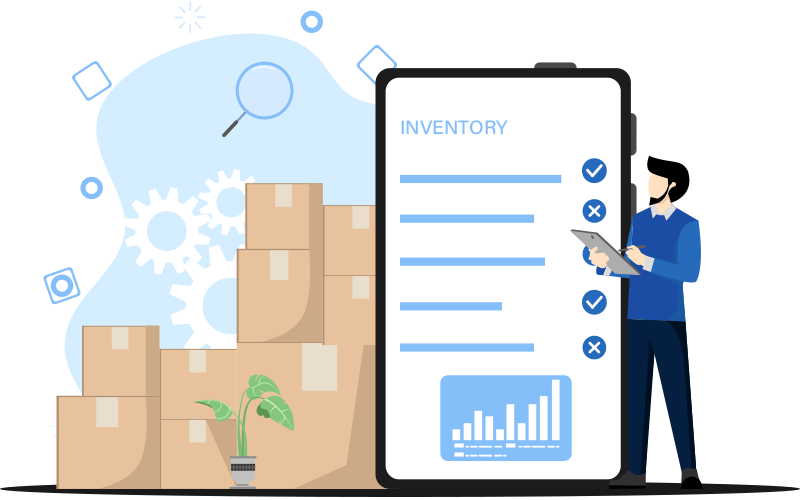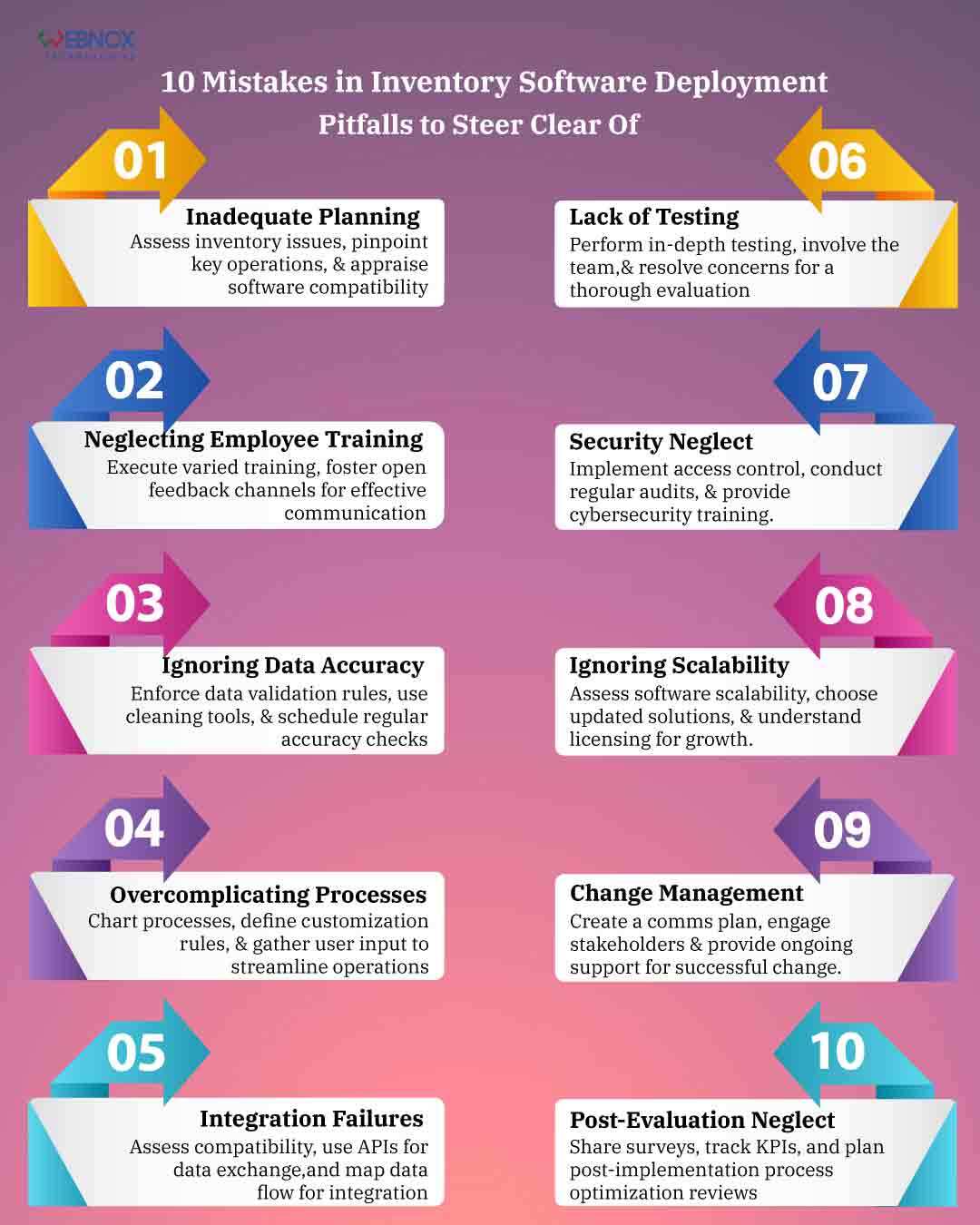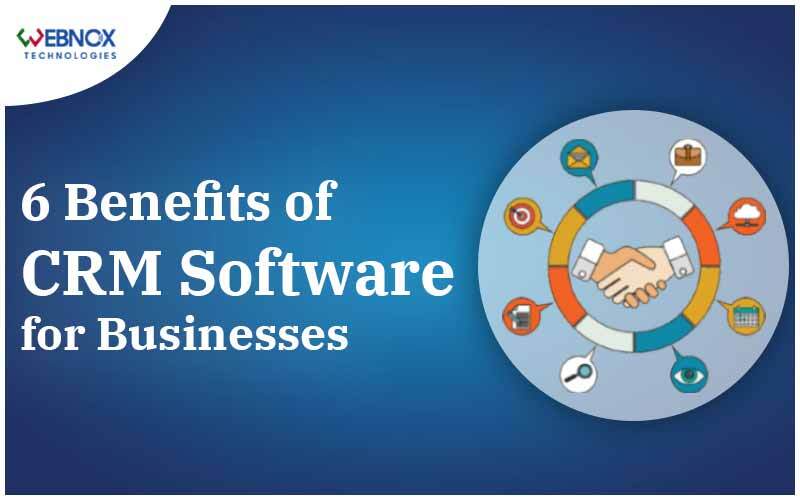10 Inventory Management Software Implementation Mistakes & How To Overcome

Rathinakumar // 03-10-2023
10 Inventory Management Software Implementation Mistakes & How To Overcome
Setting out on the path of implementing inventory management software represents a crucial milestone for businesses. It signifies a stride towards boosting efficiency, cutting costs, and achieving greater command over your inventory. However, this undertaking isn’t devoid of its possible challenges that could thwart your progress and result in frustration. In this comprehensive blog, we’ll delve deeper into the typical errors to steer clear of when implementing inventory management software, with the goal of ensuring a smooth and successful transition.

Inadequate Planning
Commencing your inventory management software implementation without a well-thought-out plan is akin to setting sail without a map. Rushing into it without a comprehensive understanding of your business’s unique needs and requirements can lead to suboptimal choices.
Before selecting a software solution, engage in a planning phase that involves:
1. Conducting a thorough analysis of specific inventory challenges
This process is similar to diagnosing an ailment before prescribing treatment. Identify the specific pain points in your current inventory management processes, such as overstocking or inaccurate records. This understanding is essential for selecting a software solution that can effectively address these issues.
2. Identifying essential features required for efficient operations
Think of this as creating a shopping list for your software. List the must-have features for your business, like real-time tracking or demand forecasting. Your software choice should align with these requirements to ensure it meets your operational needs.
3. Evaluating how the software will integrate with your existing systems
Think of this as fitting puzzle pieces together. Inventory management doesn’t work in isolation; it should seamlessly integrate with other systems like accounting software or e-commerce platforms. Consider compatibility and ease of integration when choosing your software.
Inadequate planning might result in selecting the wrong software or overlooking critical functionalities crucial for your business’s success.
Neglecting Employee Training and Engagement
Your employees are the lifeblood of your organization, and their readiness and willingness to embrace the new software are fundamental to a successful implementation. Neglecting proper training and engagement can lead to resistance and inefficiency in the long run.
Invest in comprehensive training programs tailored to the diverse needs of your workforce. Consider a mix of strategies, including:
1. Workshops
These are like hands-on lessons. Workshops provide employees with practical experience in using the new software, allowing them to become familiar with its features and functionality.
2. One-on-one coaching
Some employees may need personalized training to address specific challenges or concerns. Offering one-on-one coaching sessions can be invaluable in such cases.
3. Online tutorials
Think of these as digital guidebooks. Create a library of online tutorials and resources that employees can access at their convenience. These tutorials should cover common tasks and troubleshooting tips.
4. User-friendly documentation
Develop user-friendly documentation that acts as a reference guide. Employees can turn to this documentation when they have questions or encounter issues. It should be clear, concise, and easily accessible.
Establish open channels for regular communication and feedback to address employee concerns and make necessary adjustments based on their input. Engaging employees in the implementation process from the start can foster a sense of ownership and enthusiasm for the new system.
Ignoring Data Accuracy and Cleanup
Building a house on a shaky foundation is a recipe for disaster, just as inventory management software heavily relies on accurate and up-to-date data. The introduction of incorrect or outdated information can set off a chain reaction of issues, including overstocking, stockouts, and inaccurate financial reporting. Therefore, prioritize data accuracy and cleanup before and during the implementation process.
Conduct regular data audits to ensure that the information fed into the system is reliable. Develop protocols for ongoing data maintenance to keep your inventory records accurate and up to date.
Consider implementing the following steps to ensure data accuracy:
1. Data Validation Rules
Set up data validation rules within your software to prevent the entry of incorrect or incomplete data. This can include requiring specific formats for product names, SKU numbers, or quantity values.
2. Data Cleaning Tools
Utilize data cleaning tools and software to act as data janitors. These tools can identify and rectify inconsistencies or errors in your existing data, helping you cleanse your data before migrating it to the new system.
3. Regular Data Checks
Implement a schedule for regular data checks and updates. This ensures that data accuracy is an ongoing priority, not just a one-time effort during implementation.
By focusing on data accuracy and cleanup, you’ll lay a solid foundation for effective inventory management with your new software.
Overcomplicating Processes
Operating a complex machine without a user manual can lead to confusion, just as overcomplicating inventory management processes during software implementation can hinder productivity. While customization is essential to meet your unique needs, simplicity should not be sacrificed. Avoid adding unnecessary steps or complexity that can confuse your team.
Collaborate closely with your software provider to strike a balance between customization and user-friendliness. Aim to simplify processes wherever possible and prioritize efficiency over unnecessary complexity.
Here are some strategies to avoid overcomplicating processes:
1. Process Mapping
Before implementing the software, create a roadmap. Map out your existing inventory management processes. Identify bottlenecks, redundancies, and areas where simplification is possible.
2. Customization Guidelines
Work with your inventory management software provider to establish clear guidelines for customization. Determine what aspects of the software can be customized and what should remain standardized.
3. User Feedback
Continuously gather feedback from your team during the implementation phase. If they find certain processes confusing or cumbersome, address these issues promptly and adjust the software accordingly.
Remember that the goal of implementing inventory management software is to streamline your operations and improve efficiency. Complexity should only be introduced when it adds value, not for its own sake
Failing to Integrate with Other Systems
Imagine a well-orchestrated symphony where one instrument plays out of tune; it disrupts the harmony. Effective inventory management necessitates seamless coordination with various other systems, such as accounting software, e-commerce platforms, and supply chain management tools. Neglecting integration can lead to duplicate data entry, errors, and operational inefficiencies.
Ensure that your chosen inventory management software offers robust integration capabilities. Verify its compatibility with your existing systems or be prepared to invest in additional integration solutions to ensure the smooth flow of data between platforms.
Here’s how to approach integration effectively:
1. Compatibility Assessment
Work closely with your software provider to assess the compatibility of your chosen inventory management software with your existing systems. This should include technical compatibility and the ability to share data in real-time.
2. APIs and Middleware
Explore the use of APIs (Application Programming Interfaces) and middleware solutions to facilitate data exchange and automate processes if necessary.
3. Data Mapping and Flow
Create a detailed map of how data will flow between systems. Identify key touchpoints and ensure that data is synchronized accurately and in a timely manner.
By prioritizing integration, you’ll avoid the headaches of manual data entry and ensure that your inventory management software functions seamlessly within your broader tech ecosystem.
Inadequate Testing
Launching a rocket without thorough tests is a risky endeavor, just as going live with your inventory management software without proper testing can lead to issues. The testing phase should encompass various scenarios, including data imports, order processing, and reporting.
Engage your team in the testing process and document any bugs or concerns that arise. Address these issues promptly to avoid disruptions during the transition phase.
Here’s a structured approach to testing:
1. User Acceptance Testing (UAT)
Involve end-users in User Acceptance Testing (UAT) to ensure that the software meets their needs and expectations. Test real-world scenarios, such as creating purchase orders, managing stock levels, and generating reports.
2. Performance Testing
Assess the software’s performance under different loads and conditions. Check for any slowdowns or bottlenecks that could impact daily operations.
3. Data Migration Testing
If you’re migrating data from an existing system, thoroughly test the data migration process to ensure that all data is transferred accurately.
4. Integration Testing
Verify that integration with other systems is working as intended. Test data exchange and synchronization to confirm that information flows seamlessly.
By conducting comprehensive testing, you’ll be well-prepared to launch your inventory management software with confidence, knowing that it has been thoroughly vetted.
Disregarding Security Measures
Leaving your front door wide open exposes your home to potential intruders, just as neglecting security measures in your inventory management software can lead to data breaches. Data security is paramount in today’s digital landscape. Ensure that your inventory management software complies with industry standards for data security and implements robust security measures.
Here are essential security measures to prioritize:
1. Access Control
Implement role-based access control (RBAC) to ensure that only authorized personnel have access to specific inventory data and functionalities. Define roles and permissions based on job responsibilities.
2. Data Encryption
Encrypt sensitive data, both in transit and at rest. This prevents unauthorized access to confidential information, even if a breach occurs.
3. Regular Security Audits
Conduct periodic security audits and vulnerability assessments to identify and address potential weaknesses in your system’s security. Stay up-to-date with security patches and updates.
4. User Training
Educate your employees about cybersecurity best practices, such as creating strong passwords, recognizing phishing attempts, and reporting suspicious activities.
By prioritizing data security, you can protect your business from potential threats and ensure the confidentiality and integrity of your inventory data.
Neglecting Scalability
Buying a car that can’t accommodate extra passengers limits your future road trips, just as selecting inventory management software that can’t scale with your business can result in costly replacements or workarounds. During the inventory management software selection process, consider your long-term needs and growth projections. Choose the inventory software that offers scalability and flexibility, allowing your inventory management processes to evolve alongside your business.
Here’s how to ensure scalability:
1. Scalability Assessment
Work with your software provider to assess the scalability of their solution. Ask about the maximum number of products, locations, and users the software can handle without performance degradation.
2. Future-Proofing
Choose an inventory management software solution that is regularly updated and improved. Check the provider’s track record of adapting to industry changes and customer needs.
3. Licensing and Pricing
Understand the licensing and pricing structure of the software, especially in relation to scalability. Ensure that adding more users or expanding your operations won’t result in prohibitive costs.
By investing in a scalable inventory management solution, you can future-proof your operations and avoid the disruption of having to migrate to a new system as your business grows.
Underestimating Change Management
Introducing a new recipe to a seasoned chef requires adjustments and adaptation, just as implementing new software represents a significant change for your organization. People can be naturally resistant to change, making effective change management crucial to the success of the implementation.
Here’s how to approach change management:
1. Communication Plan
Develop a communication plan that outlines how you will inform employees about the upcoming changes. Highlight the benefits of the new system and provide regular updates on the implementation progress.
2. Stakeholder Involvement
Involve key stakeholders from various departments in the decision-making process. Their input and buy-in are essential for successful implementation.
3. Training and Support
Offer ongoing training and support to help employees adapt to the new system. Address their concerns and provide resources for troubleshooting.
4. Feedback Mechanisms
Establish feedback mechanisms, such as suggestion boxes or regular meetings, to gather input from employees. Use this feedback to make continuous improvements to the software and processes.
By prioritizing change management, you can reduce resistance to the new system and ensure a smoother transition for your organization.
Skipping Post-Implementation Evaluation
Setting sail without regular maintenance can lead to issues at sea, just as neglecting post-implementation evaluation of your inventory management software can hinder your operations. Once your inventory management software is operational, the journey is far from over. Many businesses make the mistake of neglecting post-implementation evaluation. It is vital to regularly assess the software’s performance and its impact on your operations.
Here’s how to approach post-implementation evaluation:
1. Feedback Surveys
Distribute surveys to employees to gather their feedback on the software’s usability, effectiveness, and any challenges they’ve encountered.
2. Key Performance Indicators (KPIs)
Define KPIs related to inventory management, such as order accuracy, inventory turnover, and order fulfillment times. Monitor these metrics to assess the software’s impact.
3. Regular Reviews
Schedule regular reviews with your software provider to discuss any issues, updates, or potential enhancements. Stay informed about new features or improvements that can benefit your business.
4. Process Optimization
Continuously evaluate and optimize your inventory management processes. Identify areas where the software can be leveraged further to improve efficiency.
To conclude, the implementation of inventory management software is not merely an addition to your toolkit; it represents a profound transformation of your operations. By heeding the advice in this guide to avoid common pitfalls and approaching the implementation process with careful consideration, you can harness the full potential of your software. This will not only streamline your operations but also position your business for sustained success in the long run.
It’s important to recognize that a successful implementation is an ongoing journey, much like the maintenance of a well-oiled machine. Stay vigilant, adapt to changes, and continuously seek ways to refine your inventory management practices. With the right approach and a commitment to best practices, you can smoothly navigate the implementation process and reap the rewards of efficient inventory management.




